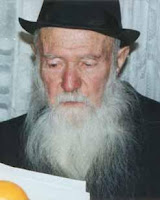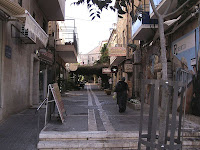“I will give them, in My
House and within My walls, a monument and a name (Yad Vashem) better than sons
or daughters. I will give them an
everlasting name which shall not perish.” Isaiah 56, 5.
 |
Hall of Remembrance,Yad Vashem.
Photo: Berthold Werner |
As night falls this Wednesday in Israel Yom
Hashoah - Holocaust Memorial Day will begin.
A state ceremony will take place that evening in Warsaw Ghetto Square at
Yad Vashem. The President and the Prime
Minister will speak. The Chief Rabbis
will recite prayers. Six torches will be
lit, each one by a survivor in memory of the six million Jews, almost two
thirds of European Jewry, who were murdered in the Holocaust.
Flags will fly at
half-mast that day. Places
of entertainment will close for 24 hours. The main television channels will broadcast only
programmes related to the Holocaust. The
radio stations will carry sombre music. At
10.00 o’clock on Thursday morning sirens will sound calling the whole country
to come to a standstill and to observe two minutes silence in memory of those
who died.
 |
Batis Family Plaque
Memorial Cave, Yad Vashem |
Millions of Ashkenazi Jews from northern and
eastern Europe were murdered during the Holocaust but its terrible impact also
reached Italian Jewry and the Sephardi communities of Greece, the Balkans and
even North Africa. One of the survivors
who will be lighting a torch at this year’s state ceremony is Artemis
Miron. She was born in Ioannina in
Greece. Her father, Iosif (Pepo) Batis, was arrested, shot
and killed in 1943. Her mother and
brother were murdered in Auschwitz in 1944.
Artemis herself survived forced labour in Auschwitz and death marches to
Ravensbruck and to Malchow.
The Jewish community in Greece is the oldest in mainland
Europe dating back more than 2,000 years.
The first written record of Jews there is from about 300 BCE. Synagogues have been discovered from the
second century BCE. In Jerusalem two synagogues have been established by Jews from Greece; one in the Ohel Moshe neighbourhood
in Nahlaot and one in the Sephardi Orphanage near to the neighbourhood of Even Israel.
Beit Knesset Beit Avraham VeOhel Sarah:
 |
Plaque on the wall of
Beit avraham VeOhel Sarah |
Ioannina is in North West Greece where Albania,
Yugoslavia and the Ionian Sea meet.
There was already a Jewish community there in the days of Alexander the
Great and it was in its day the largest Jewish community in Greece. The community spoke Judeo-Greek (Yevanic) and
used the Romaniot rite of prayer, an ancient rite that dated back to Byzantine
times.
 |
| Entrance to Beit Avraham VeOhel Sarah |
Avraham
and Sarah HaCohen came to Jerusalem from Ioannina in 1925. They had no children. Avraham died later that year and his widow
decided to consecrate their house as a synagogue for Jews from Ioannina whilst
she was still alive. She died 14 years
later in 1939 but until then she lived in a modest room at the side of the
synagogue. Nowadays Sephardi Jews pray
in this synagogue. There is no-one to
speak Yevanic and the Romaniot rite is almost never heard here. Many religious
items from the original community are preserved in the synagogue.
Beit Haknesset Kahal Tzion:
 |
| Salonica, The Fortress |
Salonica, Thessaloniki, is Greece’s second largest
city. In 1492 thousands of Sephardi Jews
settled in Ottoman Greece, many of them in Salonica, following their expulsion
from Spain and Portugal. They quickly
became the dominant group and their Judeo-Spanish language (Ladino) became the predominant
language of Greek Jewry. The Sephardim
developed Salonica into a major commercial centre. In the last quarter of the 19th
century 56% of the city’s population was Jewish. They were so influential that the city
virtually shut down each Saturday, the Jewish Sabbath. Salonica became known as the Jerusalem of the
Balkans or as “la madre de Israel” – the mother (city) of Israel. A street near my home in south Jerusalem is
called Kedoshei Saloniki – the holy ones of Salonica. It is dedicated to the memory of the 50,000
Salonica Jews who were murdered in the holocaust.
 |
| The Sephardi Orphanage, Jerusalem |
The Sephardi Orphanage in Jerusalem was established by
the Jaffa Road near Even Israel in 1908 by two Bukharian families. There have been synagogues in the orphanage
building ever since its foundation. In
the early days of the 20th century Jews from Salonica came to settle
in Even Israel. They established a
community centre and a synagogue. At
first the synagogue was in the home of Ezra Benveniste. In the 1920s the community of “Olei Salonica”
(immigrants from Salonica) moved their synagogue to the ground floor of the
orphanage where it flourished for thirty years until it joined with another
synagogue founded there by a Sephardi religious Zionist association called Al
Hamishmar (Standing Guard). Services are
still held there every day.
Postscript:
The destruction of Greek Jewry began in
1943. By the end of the Second World War
60,000 Greek Jews, 86% of the pre-war population had been killed. Today only about 5,000 Jews live in Greece
most of them in Athens and Salonica.
There are just 35 Romaniot Jews alive in Ioannina.





























+Photo+Chmee2.jpg)













